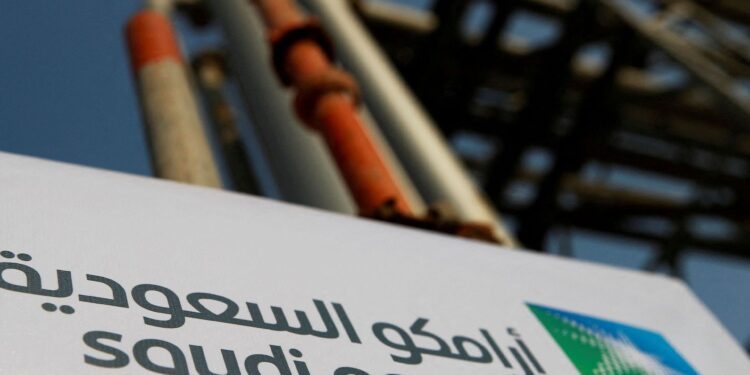The giant Saudi Aramco Group announced today, Tuesday, a decrease in its net profits by 12.39% in 2024 compared to the year 2023, for the second year in a row after achieving record profits in 2022, due to the low prices of crude oil and the sold quantities, with Saudi Arabia the largest source of black crude continued to reduce its production during the past year.
The group said in a statement published on the Saudi Stock Exchange website (Tadawul) that its net income reached 398.42 billion riyals (106.25 billion dollars) compared to 454.7 billion riyals (121.25 billion dollars) in 2023.
This decline was attributed to “low prices of crude oil and sold quantities, in addition to the low prices of refined and chemical products.”
The expected profit distributions decreased during 2025 to 320.4 billion riyals (85.4 billion dollars) announced last year, a decrease of about 30% compared to 2024, as the company faced a decrease in sales and a rise in costs.
Aramco paid profit distributions of about 124.25 billion dollars in 2024, and 97.78 billion in 2023.
The CEO of the company, Amin Al -Nasser, said in a statement, “The net strong income and the increasing basic profit distributions confirm the exceptional Saudi Aramco flexibility and its ability to benefit from the scope of its unique business, the cost of its low production, and its high levels of reliability, to provide leadership performance in the sector to our shareholders and customers,” Amin Al -Nasser CEO said in a statement.
The profits of 2024 are very far from the profits recorded in 2022, which amounted to 161.1 billion dollars, and it is a standard level, according to the company, from the cause of the war in Ukraine from an unprecedented rise in oil prices, at a peak of more than $ 130 a barrel.
This allowed the Kingdom to register the first surplus in its annual budget for nearly 10 years.
But oil prices fell in 2023 and then in 2024 to approximately $ 75 a barrel, so Aramco’s net profit in the third quarter of 2024 decreased by 15% on an annual basis, 14.5% in the first quarter and 3.4% in the second quarter.
The head of the Middle East Statistics Department at Kepler Commercial Consulting Company, Amina Bakr, indicated that the decline in Aramco’s profits was “expected”.
“The decrease in net income is caused by Saudi Arabia’s continued follow -up to OPEC Plus by submitting to collective discounts, in addition to voluntary discounts,” the French Press Agency quoted it as saying.
The effect of reducing production
Saudi Arabia’s production is currently approximately 9 million barrels per day, less than its production capacity of 12 million barrels per day.
The relatively low number reflects a series of production reduction decisions that started in October 2022, which clearly left the profits.
In addition, in April 2023, Riyadh announced a reduction of 500,000 barrels per day in the framework of a joint move with the OPEC Plus alliance and the Organization of Petroleum Exporting Countries (OPEC) and its allies – headed by Russia – to reduce supplies by more than a million barrels per day.
In June 2023, Riyadh announced an additional voluntary reduction in production by one million barrels per day.
Last December, several countries in the OPEC Plus coalition -including Saudi Arabia and Russia -agreed to extend the supply reduction for 3 months until March 2025.
Also, 8 OPEC Plus members announced that they will start gradually getting rid of voluntary production discounts of 2.2 million barrels per day starting in April, at a rate of 120 thousand barrels per month every month for 18 months.
Robert Moglniki – a resident researcher at the Arab Gulf States Institute in Washington – believes that a group of reasons includes “combining global oil surplus, abundant reserve production capacity, unconfirmed global demand, and many political references issued by the administration of (US President Donald) Trump will all affect oil prices.”
He continued, “The prices have been less than that Gulf governments like Saudi Arabia want to see, and the Saudi government and most other governments in the region will need to continue to spend smartly.”
amendment
Aramco is not the only major company in the energy sector that recorded a decrease in profits. The British Dutch company, Shell, recorded a 17% decrease in its profits last year, and the French company Total Energy recorded a 26% decrease.
In April, the International Monetary Fund said that at current production levels, the oil tie price in the Kingdom will be $ 96.2 a barrel.
“Jadwa Investment”, its headquarters, said that Brent crude – which is the international standard – will be much less than that price.
The company expected in a report last February that “Brent crude prices would be at $ 75 a barrel in 2025 and 2026 on average, low from $ 80 a barrel in 2024.”
“It is known that Saudi Arabia adjusts its budget according to the conditions of the market, and the Kingdom does not target a specific price for oil (…), and projects and plans can be adjusted continuously.”
The Saudi Ministry of Finance pointed out last September that it expects a budget deficit of 2.3% of GDP in 2025 and the continuation of the deficit until the year 2027.
The Saudi government currently has 81.5% of Aramco’s shares.
Aramco was included in the Saudi Stock Exchange in 2019 after the largest preliminary public offering in the world, which amounted to $ 29.4 billion in exchange for selling 1.7% of its shares, while a secondary offering last year raised about 1.7 billion shares 12.35 billion dollars.



